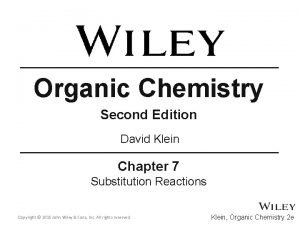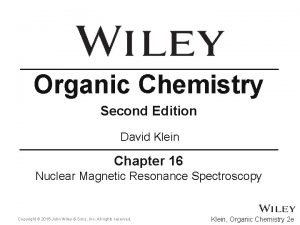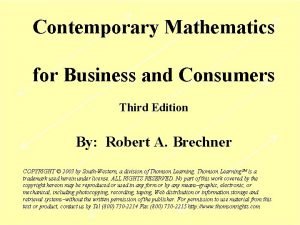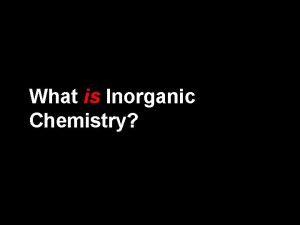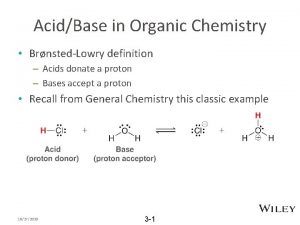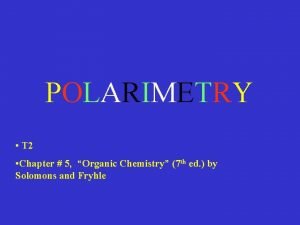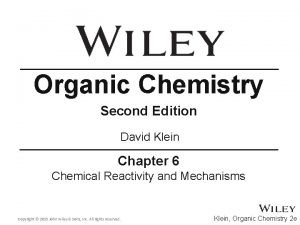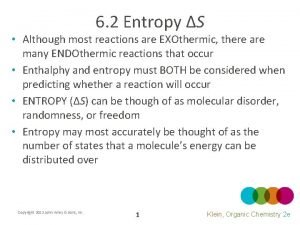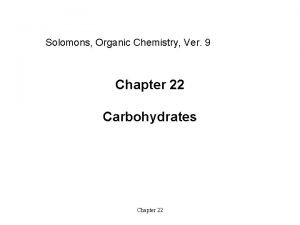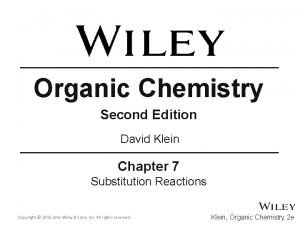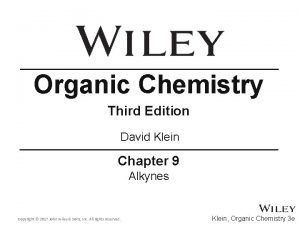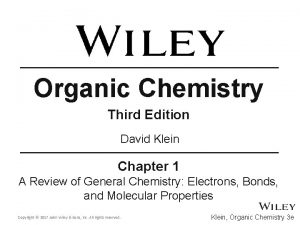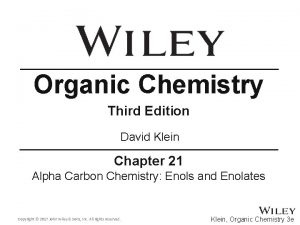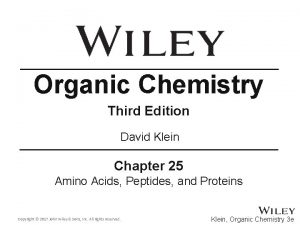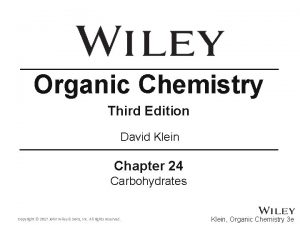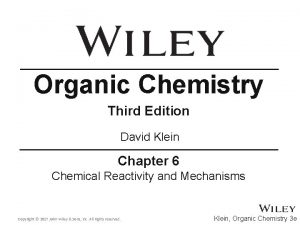Organic Chemistry Third Edition David Klein Chapter 13





































































- Slides: 69

Organic Chemistry Third Edition David Klein Chapter 13 Ethers and Epoxides; Thiols and Sulfides Copyright © 2017 John Wiley & Sons, Inc. All rights reserved. Klein, Organic Chemistry 3 e

13. 1 Introduction to Ethers • An ether group includes an oxygen atom that is bonded to two alkyl groups • -R groups can be alkyl, aryl, or vinyl groups (not acyl groups) this is an ester, (not an ether) Copyright © 2017 John Wiley & Sons, Inc. All rights reserved. 13 -2 Klein, Organic Chemistry 3 e

13. 1 Introduction to Ethers • Ether is a common function group in many natural and synthetic compounds Copyright © 2017 John Wiley & Sons, Inc. All rights reserved. 13 -3 Klein, Organic Chemistry 3 e

13. 2 Naming Ethers • Common names are often used for ether: 1. Name each –R group 2. Arrange them alphabetically 3. End with the word, “ether” Copyright © 2017 John Wiley & Sons, Inc. All rights reserved. 13 -4 Klein, Organic Chemistry 3 e

13. 2 Naming Ethers • IUPAC systematic names: 1. The larger –R group is the parent chain 2. The smaller –R group is the alkoxy substituent • Practice with Skill. Builder 13. 1 Copyright © 2017 John Wiley & Sons, Inc. All rights reserved. 13 -5 Klein, Organic Chemistry 3 e

13. 3 Structure and Properties of Ethers • The bond angle in ethers is very similar to that found in water and in alcohols – The oxygen atom is sp 3 hybridized – The larger the –R group, the wider the bond angle Copyright © 2017 John Wiley & Sons, Inc. All rights reserved. 13 -6 Klein, Organic Chemistry 3 e

13. 3 Structure and Properties of Ethers • Recall alcohols have relatively high boiling points, as a result of Hbonding • Ethers can act only as H-bond acceptors Copyright © 2017 John Wiley & Sons, Inc. All rights reserved. 13 -7 Klein, Organic Chemistry 3 e

13. 3 Structure and Properties of Ethers • Ethers cannot H-bond among themselves, and so their BP’s are much lower than alcohols of comparable size: • The larger the ether, the higher the BP (London dispersion forces) Copyright © 2017 John Wiley & Sons, Inc. All rights reserved. 13 -8 Klein, Organic Chemistry 3 e

13. 3 Structure and Properties of Ethers • Ethers are common solvents used for organic reactions: Relatively low boiling points (easily removed by evaporation) They are fairly unreactive Copyright © 2017 John Wiley & Sons, Inc. All rights reserved. 13 -9 Klein, Organic Chemistry 3 e

13. 4 Crown Ethers • Metal atoms with a full or partial positive charge are stabilized by ether solvents Ethers are used as solvents for Grignard reactions because they stabilize the Mg atom Copyright © 2017 John Wiley & Sons, Inc. All rights reserved. 13 -10 Klein, Organic Chemistry 3 e

13. 4 Crown Ethers • Crown ethers have been shown to form especially strong attractions to metal atoms. • The multiple ether groups result in stronger metal attraction • They #’s in their names refer to the total number of atoms, and the number of oxygens Copyright © 2017 John Wiley & Sons, Inc. All rights reserved. 13 -11 Klein, Organic Chemistry 3 e

13. 4 Crown Ethers • The size of the metal must match the size of the crown to form a strong attraction • 18 -crown-6 is the ideal size to trap a potassium cation Copyright © 2017 John Wiley & Sons, Inc. All rights reserved. 13 -12 Klein, Organic Chemistry 3 e

13. 4 Crown Ethers • Metal ions are not soluble in low polarity solvents. • The crown ether complexes to the metal cation, and the resulting complex is soluble • Crown ethers are used to help ionic salts, needed for organic reactions, to dissolve in organic solvents Copyright © 2017 John Wiley & Sons, Inc. All rights reserved. 13 -13 Klein, Organic Chemistry 3 e

13. 4 Crown Ethers • The F- ion below is ready to react because the K+ ion is “hosted” by 18 -crown-6 • Without the crown ether, the solubility of KF in benzene is miniscule Copyright © 2017 John Wiley & Sons, Inc. All rights reserved. 13 -14 Klein, Organic Chemistry 3 e

13. 4 Crown Ethers • Choosing a crown ether depends on the metal cation present in a reaction: • Practice with Conceptual Checkpoint 13. 4 Copyright © 2017 John Wiley & Sons, Inc. All rights reserved. 13 -15 Klein, Organic Chemistry 3 e

13. 5 Preparation of Ethers • Industrially, diethyl ether is prepared by the acid-catalyzed dehydration of ethanol • Simple, symmetrical ethers can be prepared this way Copyright © 2017 John Wiley & Sons, Inc. All rights reserved. 13 -16 Klein, Organic Chemistry 3 e

13. 5 Preparation of Ethers • The Williamson ether synthesis is a viable approach for many asymmetrical ethers Copyright © 2017 John Wiley & Sons, Inc. All rights reserved. 13 -17 Klein, Organic Chemistry 3 e

13. 5 Preparation of Ethers • The Williamson ether synthesis is a viable approach for many asymmetrical ethers • Since this is SN 2 substitution, it only works well with unhindered (1˚ and methyl) alkyl halides Copyright © 2017 John Wiley & Sons, Inc. All rights reserved. 13 -18 Klein, Organic Chemistry 3 e

13. 5 Preparation of Ethers • Consider the two possible routes to synthesize methyl t-butyl ether via Williamson ether synthesis This route will work because it requires a methyl halide This route will not work as it requires a 3˚ halide • Practice with Skill. Builder 13. 2 Copyright © 2017 John Wiley & Sons, Inc. All rights reserved. 13 -19 Klein, Organic Chemistry 3 e

13. 5 Preparation of Ethers • Recall that oxymercuration-demercuration can be used to synthesize alcohols from alkenes (section 8. 6) • Markovnikov regioselectivity Copyright © 2017 John Wiley & Sons, Inc. All rights reserved. 13 -20 Klein, Organic Chemistry 3 e

13. 5 Preparation of Ethers • Similarly, alkoxymercuration-demercuration can be used to synthesize ethers • Also Markovnikov regioselectivity • Practice Conceptual Checkpoints 13. 7 -13. 9 Copyright © 2017 John Wiley & Sons, Inc. All rights reserved. 13 -21 Klein, Organic Chemistry 3 e

13. 6 Reactions of Ethers • Ethers can undergo acid-promoted cleavage Copyright © 2017 John Wiley & Sons, Inc. All rights reserved. 13 -22 Klein, Organic Chemistry 3 e

13. 6 Reactions of Ethers • Acidic cleavage of ethers to produce an alkyl halide works with HBr and HI • If –R group is 3˚ then cleave occurs via SN 1 mechanism • If –R group is aryl or vinyl, substitution doesn’t occur: • Practice with conceptual checkpoint 13. 10 Copyright © 2017 John Wiley & Sons, Inc. All rights reserved. 13 -23 Klein, Organic Chemistry 3 e

13. 6 Reactions of Ethers • Recall (section 10. 9) ethers undergo autooxidation: • laboratory samples of ether must be frequently tested for the presence of hydroperoxides before they are used (explosive). • The autooxidation occurs through a free radical mechanism Copyright © 2017 John Wiley & Sons, Inc. All rights reserved. 13 -24 Klein, Organic Chemistry 3 e

13. 6 Reactions of Ethers Copyright © 2017 John Wiley & Sons, Inc. All rights reserved. 13 -25 Klein, Organic Chemistry 3 e

13. 6 Reactions of Ethers • Recall that the net reaction is the sum of the propagation steps Copyright © 2017 John Wiley & Sons, Inc. All rights reserved. 13 -26 Klein, Organic Chemistry 3 e

13. 7 Nomenclature of Epoxides • For cyclic ethers, the size of the ring determines the parent name of the molecule • Oxiranes are also known as epoxides Copyright © 2017 John Wiley & Sons, Inc. All rights reserved. 13 -27 Klein, Organic Chemistry 3 e

13. 7 Nomenclature of Epoxides • An epoxide can have up to 4 –R groups • Although they are unstable, epoxides are found commonly in nature Copyright © 2017 John Wiley & Sons, Inc. All rights reserved. 13 -28 Klein, Organic Chemistry 3 e

13. 7 Nomenclature of Epoxides • There are two methods for naming epoxides 1. The oxygen is treated as a side group, and two numbers are given as its locants 2. Oxirane is used as the parent name Copyright © 2017 John Wiley & Sons, Inc. All rights reserved. 13 -29 Klein, Organic Chemistry 3 e

13. 8 Preparation of Epoxides • Recall that epoxides can be formed when an alkene is treated with a peroxy acid • MCPBA and peroxyacetic acid are most commonly used Copyright © 2017 John Wiley & Sons, Inc. All rights reserved. 13 -30 Klein, Organic Chemistry 3 e

13. 8 Preparation of Epoxides • Epoxidation of an alkene is stereospecific Copyright © 2017 John Wiley & Sons, Inc. All rights reserved. 13 -31 Klein, Organic Chemistry 3 e

13. 8 Preparation of Epoxides • Epoxides are also be synthesized from halohydrins • Halohydrins are synthesized from an alkene Copyright © 2017 John Wiley & Sons, Inc. All rights reserved. 13 -32 Klein, Organic Chemistry 3 e

13. 8 Preparation of Epoxides Copyright © 2017 John Wiley & Sons, Inc. All rights reserved. 13 -33 Klein, Organic Chemistry 3 e

13. 8 Preparation of Epoxides • Note that either route, from alkene to epoxide, is stereospecific: • Practice with Skill. Builder 13. 3 Copyright © 2017 John Wiley & Sons, Inc. All rights reserved. 13 -34 Klein, Organic Chemistry 3 e

13. 9 Enantioselective Epoxidation • The epoxidation methods we have discussed so far are NOT enantioselective • Epoxidation of an achiral alkene produces a racemic mixture Copyright © 2017 John Wiley & Sons, Inc. All rights reserved. 13 -35 Klein, Organic Chemistry 3 e

13. 9 Enantioselective Epoxidation • The epoxidation forms a racemic mixture because the alkene can react on either face • To selectively react with one face of the alkene, a chiral catalyst would have to be used Copyright © 2017 John Wiley & Sons, Inc. All rights reserved. 13 -36 Klein, Organic Chemistry 3 e

13. 9 Enantioselective Epoxidation • The Sharpless catalyst is a chiral complex of titanium tetraisoproxide and diethyl tartrate. • This catalyst will cause an enantioselective epoxidation of an allylic alcohol Copyright © 2017 John Wiley & Sons, Inc. All rights reserved. 13 -37 Klein, Organic Chemistry 3 e

13. 9 Enantioselective Epoxidation • A given enantiomer of the catalyst (DET) will favor the formation of a given enantiomer of the epoxide: Copyright © 2017 John Wiley & Sons, Inc. All rights reserved. 13 -38 Klein, Organic Chemistry 3 e

13. 9 Enantioselective Epoxidation • A given enantiomer of the catalyst (DET) will favor the formation of a given enantiomer of the epoxide: • Practice with Conceptual Checkpoint 13. 5 Copyright © 2017 John Wiley & Sons, Inc. All rights reserved. 13 -39 Klein, Organic Chemistry 3 e

13. 10 Ring-opening Reactions of Epoxides • Epoxides are useful synthetic intermediates • Because of their significant ring strain, epoxides are reactive towards weak and strong nucleophiles, such as: – – Grignard reagents Hydride reagents Alcohols alkoxides Copyright © 2017 John Wiley & Sons, Inc. All rights reserved. 13 -40 Klein, Organic Chemistry 3 e

13. 10 Ring-opening Reactions of Epoxides • Strong nucleophiles react readily with epoxides • Opening of the ring is thermodynamically favored due to the relief of ring strain. Copyright © 2017 John Wiley & Sons, Inc. All rights reserved. 13 -41 Klein, Organic Chemistry 3 e

13. 10 Ring-opening Reactions of Epoxides • Although alkoxides are typically not good leaving groups, ring-opening of the epoxide is thermodynamically favored Copyright © 2017 John Wiley & Sons, Inc. All rights reserved. 13 -42 Klein, Organic Chemistry 3 e

13. 10 Ring-opening Reactions of Epoxides • Epoxides can be opened by many other strong nucleophiles as well • Ring opening of an epoxide is regioselective and stereoselective Copyright © 2017 John Wiley & Sons, Inc. All rights reserved. 13 -43 Klein, Organic Chemistry 3 e

13. 10 Ring-opening Reactions of Epoxides • Regioselectivity - Epoxide ring-opening is SN 2, and so the least hindered carbon is more reactive towards a strong nucleophile. Copyright © 2017 John Wiley & Sons, Inc. All rights reserved. 13 -44 Klein, Organic Chemistry 3 e

13. 10 Ring-opening Reactions of Epoxides • Stereoselectivity – as with SN 2, inversion of configuration is observed. • Practice with Skill. Builder 13. 4 Copyright © 2017 John Wiley & Sons, Inc. All rights reserved. 13 -45 Klein, Organic Chemistry 3 e

13. 10 Ring-opening Reactions of Epoxides • Acidic conditions can also be used to open epoxides with a weak nucleophile (HCl, HBr, water, or an alcohol) Copyright © 2017 John Wiley & Sons, Inc. All rights reserved. 13 -46 Klein, Organic Chemistry 3 e

13. 10 Ring-opening Reactions of Epoxides • Water or an alcohol can also be used as the nucleophile under acidic conditions • Antifreeze (ethylene glycol) is made industrially by this method Copyright © 2017 John Wiley & Sons, Inc. All rights reserved. 13 -47 Klein, Organic Chemistry 3 e

13. 10 Ring-opening Reactions of Epoxides • Acid-catalyzed mechanism: Copyright © 2017 John Wiley & Sons, Inc. All rights reserved. 13 -48 Klein, Organic Chemistry 3 e

13. 10 Ring-opening Reactions of Epoxides • Under acidic, conditions, Nu attack still occurs at the less substituted carbon, if a 1˚ and a 2˚ carbon are present: • But if a 3˚ carbon is present, then the Nu attacks there: Copyright © 2017 John Wiley & Sons, Inc. All rights reserved. 13 -49 Klein, Organic Chemistry 3 e

13. 10 Ring-opening Reactions of Epoxides • Since the epoxide is cationic under acidic conditions, electronic effects result in the C-O bond to a 3˚ carbon to be much weaker • But, if a 3˚ carbon is not present, then steric effects dominate Copyright © 2017 John Wiley & Sons, Inc. All rights reserved. 13 -50 Klein, Organic Chemistry 3 e

13. 10 Ring-opening Reactions of Epoxides • But, under acidic conditions, inversion of configuration is still observed, regardless of which carbon of the epoxide is attacked: • Practice with Skill. Builder 13. 5 Copyright © 2017 John Wiley & Sons, Inc. All rights reserved. 13 -51 Klein, Organic Chemistry 3 e

13. 11 Thiols and Sulfides • Sulfur appears just under oxygen on the periodic table • Thiol (-SH group): sulfur analog of an alcohol • The name of a compound with an –SH group ends in “thiol” rather than “ol” • Thiols are also called mercaptans Copyright © 2017 John Wiley & Sons, Inc. All rights reserved. 13 -52 Klein, Organic Chemistry 3 e

13. 11 Thiols and Sulfides • The mercapto- prefix is used to name –SH as a substituent Dimercaprol is used to treat mercury poisoning Copyright © 2017 John Wiley & Sons, Inc. All rights reserved. 13 -53 Klein, Organic Chemistry 3 e

13. 11 Thiols and Sulfides • Thiols are known for their unpleasant odor • Skunks use thiols as a defense mechanism • Methanethiol is added to natural gas (methane) so that gas leaks can be detected • The hydrosulfide ion (HS-) is a strong nucleophile and a weak base • HS- promotes SN 2 rather than E 2 Copyright © 2017 John Wiley & Sons, Inc. All rights reserved. 13 -54 Klein, Organic Chemistry 3 e

13. 11 Thiols and Sulfides • 1˚ and 2˚ thiols can be synthesized from SN 2 reaction of Na. SH with an alkyl halide: • Practice with Conceptual Checkpoint 13. 20 Copyright © 2017 John Wiley & Sons, Inc. All rights reserved. 13 -55 Klein, Organic Chemistry 3 e

13. 11 Thiols and Sulfides • Thiols are oxidized to disulfides with Br 2 under basic conditions: Copyright © 2017 John Wiley & Sons, Inc. All rights reserved. 13 -56 Klein, Organic Chemistry 3 e

13. 11 Thiols and Sulfides • A disulfide can be reduced to corresponding thiols with Zn metal: • The interconversion between thiol and disulfide can also occur directly via a free radical mechanism. • The bond dissociation energy of a S-S bond is only about 53 kcal/mol, and so the bond is easily made and broken (the shape of proteins relies on this bond being easily broken and made). Copyright © 2017 John Wiley & Sons, Inc. All rights reserved. 13 -57 Klein, Organic Chemistry 3 e

13. 11 Thiols and Sulfides • Sulfur analogs of ethers are called sulfides or thioethers • Sulfides can also be named as a substituent Copyright © 2017 John Wiley & Sons, Inc. All rights reserved. 13 -58 Klein, Organic Chemistry 3 e

13. 11 Thiols and Sulfides • Sulfides are generally prepared by nucleophilic attack of a thiolate on an alkyl halide • Recall that thiolates are formed be deprotonating a thiol with Na. OH. Copyright © 2017 John Wiley & Sons, Inc. All rights reserved. 13 -59 Klein, Organic Chemistry 3 e

13. 11 Thiols and Sulfides • Sulfides undergo a number of reactions: 1. SN 2 substitution with an alkyl halide – The product is a strong alkylating reagent that can add an alkyl group to a variety of nucleophiles Copyright © 2017 John Wiley & Sons, Inc. All rights reserved. 13 -60 Klein, Organic Chemistry 3 e

13. 11 Thiols and Sulfides 2. Sulfides can also be oxidized to sulfoxides or sulfones: • The choice of oxidizing agent depends on whether one needs to make a sulfoxide or a sulfone Copyright © 2017 John Wiley & Sons, Inc. All rights reserved. 13 -61 Klein, Organic Chemistry 3 e

13. 11 Thiols and Sulfides 2. Sulfides can also be oxidized to sulfoxides or sulfones • Sodium meta-periodiate can be used to form the sulfoxide • Hydrogen peroxide can be used to form a sulfone Copyright © 2017 John Wiley & Sons, Inc. All rights reserved. 13 -62 Klein, Organic Chemistry 3 e

13. 11 Thiols and Sulfides • The S=O bond has very little double bond character, the 2 p orbital on O poorly overlaps with the larger, 3 p orbital on the S Sulfoxide Sulfone Significant resonance contributors Copyright © 2017 John Wiley & Sons, Inc. All rights reserved. 13 -63 Klein, Organic Chemistry 3 e

13. 11 Thiols and Sulfides • Because sulfides are readily oxidized, they make good reducing agents • DMS is used to reduce the ozonide and complete an ozonolysis reaction • Practice with conceptual checkpoint 13. 21 Copyright © 2017 John Wiley & Sons, Inc. All rights reserved. 13 -64 Klein, Organic Chemistry 3 e

13. 12 Synthesis Strategies w/ Epoxides • Epoxides allow for installing two functional groups on adjacent carbons: • Whenever you see two adjacent functional groups, you should think of epoxide (made from an alkene) as the starting material: 1) m. CPBA 2) Na. CN • Practice with Skill. Builder 13. 6 Copyright © 2017 John Wiley & Sons, Inc. All rights reserved. 13 -65 Klein, Organic Chemistry 3 e

13. 12 Synthesis Strategies w/ Epoxides • By reacting an epoxide with a Grignard reagent, the carbon skeleton can be modified: • Think of the alkyl halide as the starting material, to which carbons will be added via Grignard reagent • The epoxide consists of the carbon chain that will be added to the alkyl halide Copyright © 2017 John Wiley & Sons, Inc. All rights reserved. 13 -66 Klein, Organic Chemistry 3 e

13. 12 Synthesis Strategies w/ Epoxides • An epoxide yields a longer carbon chain, with a functional group on the 2 nd carbon of the newly installed chain • A carbonyl would be used to install a functional group on the 1 st carbon of the newly installed part of the chain: Copyright © 2017 John Wiley & Sons, Inc. All rights reserved. 13 -67 Klein, Organic Chemistry 3 e

13. 12 Synthesis Strategies w/ Epoxides • Consider the reagents necessary to accomplish the synthesis below: Copyright © 2017 John Wiley & Sons, Inc. All rights reserved. 13 -68 Klein, Organic Chemistry 3 e

13. 12 Synthesis Strategies w/ Epoxides • Consider the reagents necessary to accomplish the synthesis below: • We need to add a 3 -carbon chain, with the functional group on the 2 nd carbon of the new chain… so an epoxide should be used: • Practice with Skill. Builder 13. 7 Copyright © 2017 John Wiley & Sons, Inc. All rights reserved. 13 -69 Klein, Organic Chemistry 3 e
 Organic chemistry third edition david klein
Organic chemistry third edition david klein Organic chemistry third edition david klein
Organic chemistry third edition david klein Organic chemistry david klein 3rd edition
Organic chemistry david klein 3rd edition Nomenclature of ethers
Nomenclature of ethers Organic chemistry
Organic chemistry Organic chemistry 2nd edition klein
Organic chemistry 2nd edition klein Klein organic chemistry 2nd edition
Klein organic chemistry 2nd edition Organic chemistry (3rd) edition chapter 1 problem 16s
Organic chemistry (3rd) edition chapter 1 problem 16s Halohydrin formation
Halohydrin formation Ib organic chemistry
Ib organic chemistry Inorganic vs organic chemistry
Inorganic vs organic chemistry Organic vs inorganic compounds
Organic vs inorganic compounds Chapter 22 review organic chemistry section 1 answers
Chapter 22 review organic chemistry section 1 answers Organic chemistry chapter 9
Organic chemistry chapter 9 Chapter 7 chemistry review
Chapter 7 chemistry review Chapter 3 organic chemistry
Chapter 3 organic chemistry Organic chemistry chapter 1 problem 59pp
Organic chemistry chapter 1 problem 59pp Finns modification of cavity preparation
Finns modification of cavity preparation Senile carious lesions
Senile carious lesions David klein
David klein Organic chemistry
Organic chemistry Principles of economics third edition oxford pdf
Principles of economics third edition oxford pdf Business mathematics third edition
Business mathematics third edition Modern operating systems tanenbaum
Modern operating systems tanenbaum Fundamentals of corporate finance third canadian edition
Fundamentals of corporate finance third canadian edition Sujata madan
Sujata madan Lifespan development third edition
Lifespan development third edition Lifespan development third edition
Lifespan development third edition Essential cell biology chapter 1
Essential cell biology chapter 1 Dr ruth yates
Dr ruth yates Founder of organic chemistry
Founder of organic chemistry Chemistry of soap making
Chemistry of soap making Ester organic chemistry
Ester organic chemistry Alcohol formula
Alcohol formula Ee organic chemistry
Ee organic chemistry Ario organic chemistry
Ario organic chemistry Ario practice problems
Ario practice problems In iupac naming priority order
In iupac naming priority order Objective lab report example
Objective lab report example Alkane organic chemistry
Alkane organic chemistry Organic chemistry grade 10
Organic chemistry grade 10 Organic chemistry
Organic chemistry Organic chemistry wade
Organic chemistry wade Prop but pent
Prop but pent Cracking organic chemistry
Cracking organic chemistry But prop
But prop Organic chemistry myanmar
Organic chemistry myanmar Electrophilic addition hbr
Electrophilic addition hbr Alpha cleavage
Alpha cleavage Hono organic chemistry
Hono organic chemistry Vicinal dihalide
Vicinal dihalide Organic chemistry topic 11
Organic chemistry topic 11 Organic chemistry reaction pathways
Organic chemistry reaction pathways Organic chemistry nomenclature
Organic chemistry nomenclature What is organic chemistry like
What is organic chemistry like Neon organic or inorganic
Neon organic or inorganic Organic chemistry vocabulary
Organic chemistry vocabulary Organic chemistry laboratory ch 2540 manual
Organic chemistry laboratory ch 2540 manual A level chemistry ocr organic synthesis
A level chemistry ocr organic synthesis Fatty acids definition
Fatty acids definition Ario organic chemistry
Ario organic chemistry How to calculate yield in chemistry
How to calculate yield in chemistry Polarimetry organic chemistry
Polarimetry organic chemistry Radicals
Radicals Hammonds postulate
Hammonds postulate Chemistry-ethics case studies
Chemistry-ethics case studies Hammond's postulate organic chemistry
Hammond's postulate organic chemistry Lewis dot structure ch4
Lewis dot structure ch4 Carbohydrates organic chemistry
Carbohydrates organic chemistry Organic chemistry
Organic chemistry



















